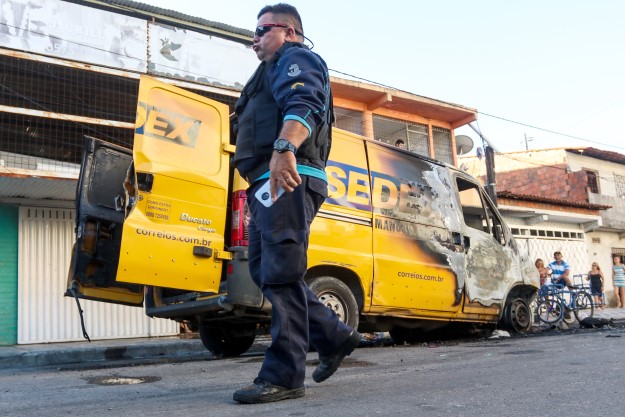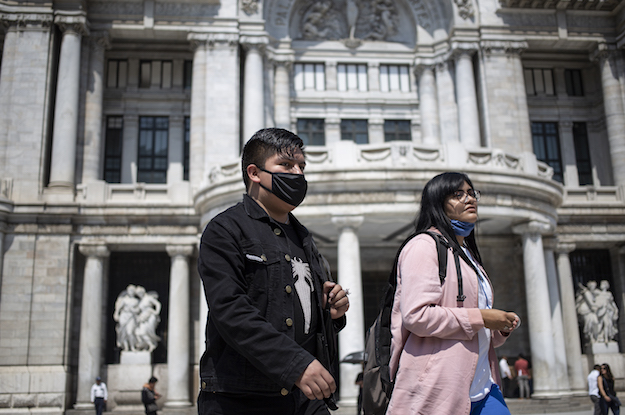One evening in late June, guards at a state prison near Fortaleza in the Brazilian state of Ceará aimed their guns at a drone hovering above the jail and shot it down. A few hours later they proudly showed off their catch to journalists: three brand new Samsung mobile phones, a charger and four SIM cards.
The incident marked one more small advance in the battle to control the state’s lawless prisons, part of a hard-line state security policy that chimes with the approach favored at the national level by right-wing President Jair Bolsonaro. And – at first glance – it appears to be working.
Outside the prison system, violent crime has been falling across Brazil in recent months, partly as a result of more aggressive policing methods. But nowhere has the improvement been more apparent than in Ceará. When I visited in May 2018, the state was the third most violent in the country, as rival gangs fought a vicious battle for control of a booming drugs market.
Renato Roseno, a 47-year-old state congressman and left-wing activist, had shown me how gangs were using social media to broadcast the results of the violence. I remember in particular a WhatsApp image of a young man’s tortured and dismembered body reassembled on a wheelbarrow. “It’s madness,” Roseno told me.
Fifteen months on, Ceará’s poorer districts are still dangerous but the death rate has been cut in half, an improvement twice as great as the national average. From third place, Ceará is now only the 14th most dangerous of Brazil’s 27 states.
Most surprising is that this progress is the work of an administration controlled by the left-wing Workers’ Party (PT), that has often been at odds with the iron hand instincts of Bolsonaro and the far right. The PT has tended to advocate a softer approach, putting much more emphasis on prevention and development.
But late in 2017, ahead of last year’s elections and amid popular clamor for a crackdown, party leaders in Ceará opted to take a different path. The shift has proved popular. Camilo Santana was elected for a second term as governor with a thumping majority in October.
“People were demanding a hard line against crime and the governor listened,” André Costa, the state’s security secretary, told AQ. “The demand (transcended any ideological consideration). It’s not a question of being right wing or left wing. People were saying that the police had to act with greater firmness.”
The state stepped up with increased spending in security. Thousands of new police officers have been recruited – there are now 6,000 more military police officers than there were in 2015. An additional 2,000 officers have been recruited to the civil police, effectively the state’s investigative force. And there are more than 1,000 new prison guards. Police officers are also better armed than they were: The state bought 15,000 Sig Sauer 320s pistols, the model deployed by the U.S. military.
Money has also been spent on security cameras. More than 3,300 have been installed across the state. The same goes for investment in computing and information technology, with law enforcement agents now able to summon up crucial data about suspects at the touch of a button on their mobile phones. Costa said that increased spending in the most dangerous neighborhoods, on things like street lighting and cleaning up buildings defaced by gang graffiti, has also helped the security drive.
But the biggest improvements have come since Luis Mauro Albuquerque, a no-nonsense disciplinarian, was put in charge of the prison system in December. Across Brazil over the last two or three decades, organized crime gangs – such as São Paulo-based First Capital Command (PCC) and Rio de Janeiro-based Red Command – have been able to dominate the prison system, often with the acquiescence of administrators.
Using cell phones, gang leaders often run their drug empires from inside prison walls, ordering actions against rivals or just using the prison itself as a place to slaughter rivals, as in the recent rebellions in the northern states of Pará and Amazonas. In Ceará, a sociologist told me last May that entire favelas housing prisoners’ families and controlled by separate gangs had begun to sprout around the state’s prisons.
Albuquerque has changed all that. In Ceará rival gang members have been forced to share cells. Gang leaders have been transferred to distant federal prisons. Family visits have been reduced. Televisions and electric fittings have been removed and two and a half thousand mobile phones confiscated. Efforts – however ingenious – to bypass these methods have been resisted. “(The prison crackdown) was a big blow for them,” said Costa.
According to Roseno, that improvement has come at a heavy cost in terms of human rights. “Overcrowding got worse, there is not enough food or drink and we have had many complaints about torture,” he said. A temporary truce between the warring gangs cannot necessarily be expected to continue. “It is all very tenuous and very fragile. There could be an explosion at any moment.”
Those kinds of concerns are unlikely to get any traction with a public anxious about crime levels. Roseno admits that what he calls “penal populism” is attractive to voters. But there are broader questions about whether the policy is sustainable. Short-term repressive policies might yield quick results, but international experience suggests there is a need to complement this approach with prevention measures and effective social development policies. “These take longer to have an effect, but their effect is longer lasting,” Robert Muggah, a founder of the Rio de Janeiro-based Instituto Igarapé, which analyses security trends, told AQ. “It is sometimes difficult to combine the two because the security agenda has become so politicized.”
Muggah said the effect of Ceará’s new security policies may have been enhanced by external factors, such as changes in the structure of the drug business. The recent resurgence of cocaine production in Colombia means that traffickers are now making more use of northern routes, while northeastern states like Ceará, which are linked to sources of coca and cocaine production in Peru and Bolivia, have become relatively less important.
In any event, crime statistics can be notoriously volatile. Rio de Janeiro itself managed to reduce homicide rates to a record low in 2015 only to witness a sharp increase more recently. “The improvement is dramatic, but these trends can oscillate. The tricky question is how you can sustain the improvement,” said Muggah.









